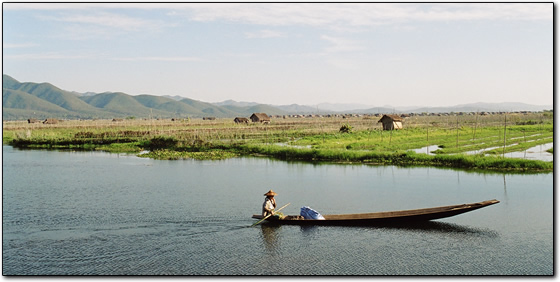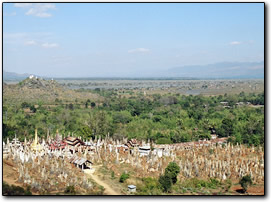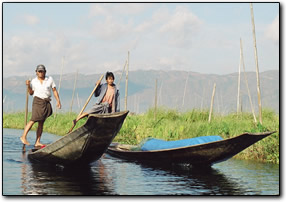
Lake Inle
From Taungoo we flagged down a night bus from the village checkpoint to Lake Inle in central Shan State, a picturesque body of water surrounded by rolling hills. Arriving at dawn at the junction, we drank a warm cup of weak black tea with condensed milk before climbing onto the back of an open pick-up for the ride into town.
We spent one day hiking to the hills above the lake. Along the way we passed small villages near fields of grain. We came upon a cave where several monks lived and left a few treats from town as offerings. Further up the mountain, a row of white stupas stood out from the surrounding brown. We climbed to a small hilltop monastery and then turned around to admire the view of the valley and lake below.
One morning we organized a boat tour of the lake. We set off just after sunrise, chugging along the river channel leading to the main body of water. First we visited a “local” market, but it turned out to be so full of souvenir stalls that it was hard to find any locals selling their own produce! Boatloads of tourists arrived just as we left. Luckily, our boatman knew another market that turned out to be more authentic. On the way in to dock we passed a large, octagonal wooden building that housed five famous Buddha images. After enjoying the market, we walked to the temple to visit. Handing under the eaves were large paintings that described the story of the statues. Some of the paintings even had subtitles in broken English, but it was difficult to understand the story. The small Buddha statues were so covered with gold leaf that they were transformed into fat, golden “blobs”. Next to the temple was a long, narrow boat covered with gilded decoration and crowned with what appeared to be the giant head of a chicken. We had seen this boat in the paintings taking the statues out onto the lake for some kind of important festival.
 |
 |
Stilt houses built of blackened teak lined the lakefront. Someone had told us that the Burmese, lacking paint or varnish, used motor oil to preserve the wood: it certainly explained the darkened appearance of their houses. Along the narrow canals, we could see locals paddling their canoes using just one leg. They evolved this way of locomotion because they needed both hands to handle their fishing nets. Even young children had mastered the technique of holding the paddle in the crook of their knee, then twisting their hips while balancing on one foot on a small platform at the back of their canoe.
We walked through a nearby village to visit one of the local monasteries and its garden of “1000 stupas”. We walked barefoot through rows and rows of crumbling, whitewashed brick chedi crowned with rusted, lilting “hti” among weeds and piles of dry, reddish dirt before climbing a nearby hill to admire the view. Looking back on the lake, we could see the vast quantities of while stupas dotting the surrounding hills under the light blue sky. Under the blazing afternoon sun, the deep blue lake shimmered with blinding light, with glints of gold from the many temples scattered around the islands.
Vast quantities of tomatoes are grown around Lake Inle. Rows and rows of tomato plants are laid out along the water, their sodden base actually floating on the water! The farmers move up and down the lines, tending their crops and harvesting the ripe, red tomatoes directly into their boats. Our lake tour finished with a stop at the famous “jumping cat” monastery. The monastery itself was impressive: a large teak building on an island in the middle of the lake with many beautifully decorated Buddha images. The monks are famous for training their cats to jump through hoops. After enough tourists had gathered, a clearly bored monk rounded up a few strays and dutifully demonstrated the jumping, repeating the trick so that everyone could get a picture. Despite constant requests, we never found any “Burmese” cats while we were in Myanmar. Whenever we asked, they would invariably indicate any kind of half-breed cat as “Burmese”. Indeed, it was a cat with Burmese citizenship, but not the kind we were looking for.
 |
 |
